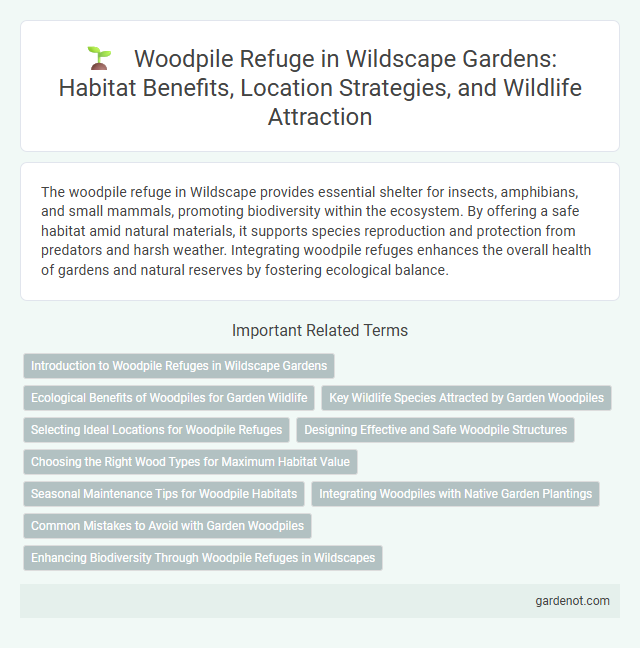The woodpile refuge in Wildscape provides essential shelter for insects, amphibians, and small mammals, promoting biodiversity within the ecosystem. By offering a safe habitat amid natural materials, it supports species reproduction and protection from predators and harsh weather. Integrating woodpile refuges enhances the overall health of gardens and natural reserves by fostering ecological balance.
Introduction to Woodpile Refuges in Wildscape Gardens
Woodpile refuges in Wildscape Gardens provide essential habitats for a variety of wildlife, promoting biodiversity and ecosystem health. These structures mimic natural woodpiles, offering shelter and breeding grounds for insects, amphibians, small mammals, and birds. Strategically placed within Wildscape Gardens, woodpile refuges support conservation efforts by enhancing local fauna populations and maintaining ecological balance.
Ecological Benefits of Woodpiles for Garden Wildlife
Woodpiles create essential habitats for numerous garden wildlife species by providing shelter, breeding sites, and hunting grounds for insects, amphibians, and small mammals. They support biodiversity by fostering decomposer organisms like fungi and invertebrates, which contribute to nutrient cycling and soil health. This natural habitat enhancement helps maintain ecological balance and promotes a thriving wildscape ecosystem.
Key Wildlife Species Attracted by Garden Woodpiles
Garden woodpiles provide essential habitats for key wildlife species such as hedgehogs, which use the decaying wood for nesting and foraging. They also attract amphibians like frogs and newts, benefiting from the moist, sheltered microhabitats created by decomposing logs. Furthermore, a variety of invertebrates including beetles, spiders, and woodlice thrive in these refuges, supporting the entire woodland ecosystem.
Selecting Ideal Locations for Woodpile Refuges
Choosing ideal locations for woodpile refuges requires prioritizing areas with natural cover and proximity to water sources to support diverse wildlife habitats. Optimal placement involves positioning woodpiles near sunny, sheltered spots to encourage insect populations and provide thermal regulation for reptiles and amphibians. Integrating woodpile refuges within existing natural structures like hedgerows or forest edges enhances connectivity and increases habitat value for small mammals, birds, and invertebrates.
Designing Effective and Safe Woodpile Structures
Designing effective and safe woodpile structures in Wildscape habitats involves using sturdy, weather-resistant materials and ensuring adequate ventilation to prevent moisture buildup and decay. Properly stacked woodpiles provide essential shelter and nesting sites for various wildlife species, promoting biodiversity within the ecosystem. Strategic placement away from high-traffic areas minimizes disturbance and enhances safety for both animals and humans.
Choosing the Right Wood Types for Maximum Habitat Value
Selecting hardwoods like oak, hickory, and maple for the Woodpile refuge enhances habitat value by providing long-lasting shelter and food sources for insects and small mammals. Softwoods such as pine and cedar decompose faster, offering quick nutrient cycling and temporary cover for amphibians and reptiles. Balancing both hardwoods and softwoods in the woodpile ensures diverse microhabitats that support a wide range of wildlife species year-round.
Seasonal Maintenance Tips for Woodpile Habitats
Seasonal maintenance of woodpile habitats in Wildscape is essential to support biodiversity and provide shelter for wildlife such as hedgehogs, insects, and amphibians. Regularly removing debris and ensuring proper aeration prevents mold and promotes a healthy microhabitat. Positioning woodpiles in shaded, sheltered spots while replenishing decaying wood optimizes conditions for nesting and hibernation throughout the year.
Integrating Woodpiles with Native Garden Plantings
Integrating woodpiles with native garden plantings enhances habitat complexity by providing shelter and foraging opportunities for local wildlife such as amphibians, insects, and small mammals. Native plants attract pollinators and contribute to soil health, creating a balanced ecosystem around the woodpile. This combination supports biodiversity and natural pest control within Wildscape habitats.
Common Mistakes to Avoid with Garden Woodpiles
Common mistakes to avoid with garden woodpiles in a wildscape include stacking wood directly on the ground, which can lead to moisture buildup and attract pests like termites and rodents. Failing to ensure proper air circulation can cause wood to rot and reduce habitat quality for beneficial insects and amphibians. Avoid placing woodpiles too close to buildings to prevent unwanted infestations and fire hazards.
Enhancing Biodiversity Through Woodpile Refuges in Wildscapes
Woodpile refuges in wildscapes create essential habitats for insects, amphibians, and small mammals, significantly enhancing local biodiversity. The layered structure of decaying wood supports nutrient cycling and provides shelter, nesting sites, and food sources that sustain diverse ecological communities. By integrating woodpile refuges, land managers promote ecosystem resilience and foster natural regeneration processes within wildscapes.
Woodpile refuge Infographic

 gardenot.com
gardenot.com